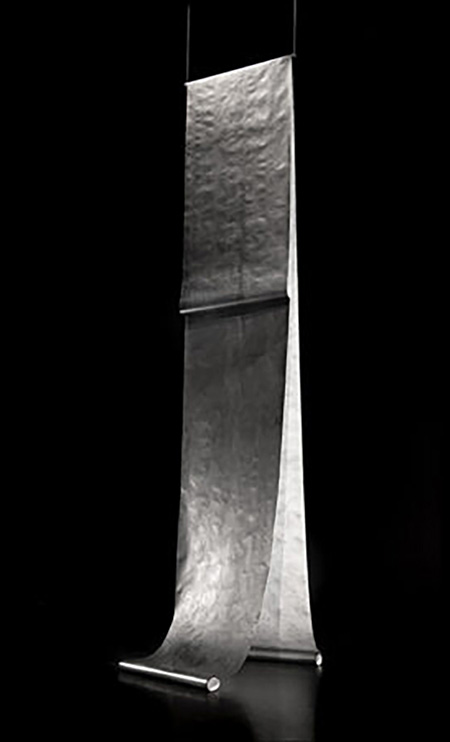
Continuing through February 27, 2022
Multiple contemporary art institutions in Santa Fe currently celebrate the longstanding practices of female-identifying artists, including “Poetic Justice” with Judith F. Baca, Mildred Howard, and Jaune Quick-to-See Smith at the New Mexico Museum of Art; Helen Pashgian’s “Presences” at Site Santa Fe and “Spheres” at Charlotte Jackson Fine Art; and Marietta Patricia Leis’s “Sense Memories” at the Center for Contemporary Art (CCA). There is something wondrous about exiting the strict shelter-at-home mandates of early pandemic life and encountering six, seven, and eight decades worth of artwork rich in conceptual inquiry.
In mounted wall text at the entrance of Leis’s show, writer Kathleen Shields describes the artist’s efforts as a “distillation of evanescent impressions, feelings, and details of memories into ostensibly simple objects …” The show opens with “Phoenix Rising #1” and “#2,” two wall-mounted cross-sections of mimosa tree trunks, each eroded in the center. They are charred using a special Shou Sugi Ban technique, meant to preserve wood, and burnished with copper. The same colors repeat throughout the exhibit: deep blacks, grays, and copper tones. A larger, entirely black diamond canvas, “Eclipse #1” also sports copper leaf along the frame of the stretcher. When viewing this painting straight on, the copper isn’t immediately visible except for an emanating orange reflection on the wall. “Eclipse #1” sets a baseline for the show, the flat, all-black painting brimming with confidence. Variations to the color and value of each picture plane becomes a conceptual focal point. This recurs in a series of works titled “Vacuities #1-4,” each containing a streak of mottled gray that suggests a horizon line. They reference Drake’s Passage, a notoriously difficult route in Antarctica, and the evocation of landscape. This is predicated by “Eclipse #1,” which suggests that the images at hand, while of personal significance to Leis, are more about viewers’ desire to locate an image and discern its topography, than they are about accessing the specific landscape Leis was inspired by.
Other portions of the exhibit are made up of small compact square color field paintings. A larger example, “AIR,” includes eighteen variously shaped (but small) prints on a painted wall, the combination of which most closely evoke digital screens. The colors themselves recall the palette of a screen saver. Another 19-panel assortment of paintings is even called “Pixel Installation,” reinforcing the relationship between flat paintings that reference memory and the digital interfaces that so often mediate our experience. The towering “The Silent Road” hangs from the ceiling and drapes down in elegant folds, its surface covered in graphite ground acrylic. The weight of imagined effort is initially striking, so it comes as a letdown to find that the surface was made of graphite paint, though burnishing is a significant part of the piece.
Whereas traditional minimalism strove to create aesthetic experiences autonomous from subjective or emotive experience, Leis’s work rather tries to excerpt slices of impressions, decontextualizing them for close examination, like small seeds from which she might recollect a specific memory. I was not surprised, therefore, to learn that during her early years as a dancer, painter, and actress living in New York in the sixties, she also studied primal scream therapy.
Ultimately, and aside from the acrylic graphite works, the exhibit doesn’t hold focus, presenting a broad swath of approaches that brush up against different questions within Leis’s identifying strategies. While I can’t help wishing that the show offered a longer, more concentrated gaze on one of those areas, the broad inquiry isn’t necessarily a bad thing. It rather captures the life of an artist’s studio over the course of a collectively difficult year featuring poetry, prints of trees, hanging painting sculptures, mounted tree trunks, and color field paintings. To that end one work, “Winter Lyrics,” becomes an especially meaningful installation. Comprising forty small wood panels that lean against the wall in gridded rows of four acrylic shelves, each individual panel is covered in graphite acrylic with a dull dark reflectivity. Each being little larger than a paint swatch, the “Winter Lyrics” provide a field for the meditation of color in hibernation.
